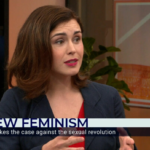A review of Baby Hunger: The New Battle for Motherhood. By Sylvia Ann Hewlett.
Atlantic Books, 2002.
Throughout much of the Western world, women are putting marriage and family on hold, while seeking to establish a career. A mate and children are still desirable goals for most women, but they are being pushed to the end of the to-do-list. But as this new book makes clear, many women have been duped by the feminist creed of career first, family second. The truth is, by the time most career women get around to finding a partner and starting a family, there are not many eligible men left, and their biological clocks have moved along, making pregnancy difficult if not impossible.
This is the big lie of feminism, that women can be successful at both a career and a family. But very few women actually achieve such an outcome. Most well-educated, high-earning career women are mate-less or childless.
These are the findings which Hewlett discovered as a result of a survey conducted among 1,647 high-achieving women. She found that 42 per cent of high-achieving women in corporate America were still childless at age 40. That figure rose to 49 per cent of women who earned $100,000 or more. Only 1 per cent of high-achieving women aged 41-55 had a first child after age 39. And only 16 per cent of these high-achievers felt they could “have it all” in terms of career and family.
Interestingly, most of these women do want to have children. But a number of factors conspire against them. Being successful in Corporate America (or Australia) requires a demanding, self-sacrificing lifestyle that hardly leaves room for successful family life. Both are full-time occupations. And many corporations offer little flexibility to women who do have a family. And in an age that belittles commitment and long-term relationships, many young men and women don’t even bother to develop secure relationships, let alone start a family.
But perhaps one of the main factors at work in all of this is the myth being peddled to many women that if they leave off childbearing to later ages, assisted reproductive technologies (ART) can come to their rescue and solve all their problems. But as Hewlett remarks, “women have been sold a bill of goods on the fertility front”. Indeed, she devotes a lengthy chapter of her book to this important issue.
The truth is, no matter how advanced ART becomes, it still is up against a stubborn fact of nature: older women have great difficulty in becoming pregnant, and the longer they wait, the less their chances of success. Women in their 40s at best have a 3 to 5 per cent chance of getting pregnant by standard IVF procedures. And 50 to 80 per cent of those women who do conceive will lose their babies through miscarriage.
But the fertility industry has become big business in America and elsewhere. The multi-billion dollar a year industry must convince women that ART can help them out, while in truth it has never had a good track record, even for younger women. But it parades success stories while covering up high failure rates. Indeed, even the statistics are abused, where success is measured in terms of pregnancy rates, instead of successful births. And there is a big difference between the two.
Not only is IVF and ART very unsuccessful, but it is also very expensive, with average costs ranging in the tens of thousands of dollars, often skyrocketing into several hundred thousands of dollars. So time and money war against career women who put off child-bearing. But feminist ideology and the greed is good mentality have blinded women to some of these hard truths.
But such truths need to be shouted from the rooftops. The longer a woman waits, the harder it will be to conceive. The later in life she begins treatment from ART, the less likely a successful birth of a healthy baby. And the risks to a woman on ART also increase. For example, women who have been treated for infertility are three times more likely to develop ovarian cancer than women who have not been.
But again, market pressures ensure that only a good face of the fertility industry is put forward. The warnings and risks are downplayed while the successes are over-hyped. And IVF workers know that baby hunger is a very strong driving force in a woman’s life, often forcing them to go to great lengths to get a child. With great profits to be made, the fertility industry is quite happy to accommodate these demands. Thus they hype their services, while they downplay the very high failure rates. And many women will pay dearly, in more ways than one.
The upshot of all this is that women need to be encouraged to change their behaviour. Hewlett argues that they should not put off finding a mate, they should not put off child-bearing, and they should not be mislead by the claims of the ART industry. Hewlett offers other proposals, like finding a company with real flexible work/family policies, and the like. But her main message to women is to stop believing the received wisdom about career and family being peddled today.
It is interesting to note that this book has received a cool reception in America. Feminists are certainly not happy with the message. Parts of corporate America are also upset. And the fertility industry is discomfited by the message presented here. But it is a message that needs to be given.
Hewlett deserves credit for risking the wrath of the femocracy to point out these simple home truths. And lest the reader think this is just an American issue, women around the Western world are struggling with these concerns. And Australia is no exception.
Women are beginning to wake up to the truth that feminism has not always played with a straight deck. Many women have been deceived, and they are now quite angry about it. Indeed, as I write this review, a fascinating article featured in the Melbourne Age. Entitled “The Sins of our Feminist Mothers,” the author takes her ideological forebears to task for the “lie of super ‘you-can-have-it-all’ feminism”. Virginia Haussegger, an ABC TV news presenter, provides an excellent example of just what Hewlett has been talking about.
She says that a whole generation of young women listened to the likes of Anne Summers, Jocelyn Scutt, Morag Fraser, and Joan Kirner, and pursued careers at the experience of relationships and children. Now, they are discovering that they cannot have it all. Haussegger writes, “I am childless and I am angry. Angry that I was so foolish to take the word of my feminist mothers as gospel. Angry that I was daft enough to believe female fulfillment came with a leather briefcase. It was wrong. It was crap.”
Strong words. But I suspect she is just the tip of the iceberg. Many other Australian women are coming to realize they have been duped big time. Thus the value of Hewlett’s book. A major rethink is needed, and the feminist movement is now beginning to go on the defensive.
Social policy, like life, demands that we stay on the straight and narrow. If we discover that we are on the wrong path, the appropriate response is to go back, find out where the path began to deviate, and get back on the right road. This book helps us to do just that.
[1228 words]



















